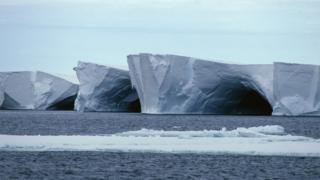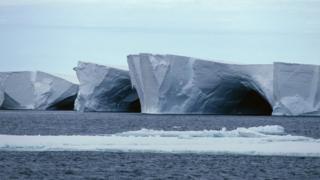Signs of faster melting in world’s largest ice shelf

 Image copyright DOUG ALLAN/SCIENCE PHOTO LIBRARY.
Image copyright DOUG ALLAN/SCIENCE PHOTO LIBRARY. Part of the world’s largest ice shelf is melting 10 times faster than the rest, shedding light on how it might respond to climate change.
The study of Antarctica’s Ross Ice Shelf reveals that one area is melting due to relatively warm ocean water getting into a cavity under the shelf.
The findings have implications for future sea-level rise.
This is because the the Ross Ice Shelf plays an important role in stabilising this wider region of Antarctica.
Details have been published in the journal Nature Geoscience.
The Ross Ice Shelf is a huge frozen block about the size of France that floats in the southern portion of Antarctica’s Ross Sea. In some areas, it can be about 750m (2,450ft) thick.
Ice shelves like this one are formed continuously by glaciers which feed them. In turn, the shelves act as a “brake” on the glaciers and also moderate the amount of melting that occurs on the glaciers’ surfaces.
In other areas of Antarctica, deep ocean water has caused some ice shelves to thin in recent years. But across its entire expanse, the Ross Ice Shelf appears to be stable.
However, scientists have spent several years building up a record of how the north-west sector of the Ross Ice Shelf interacts with the ocean beneath it.
They found that the Sun heats ocean surface water which then flows into a cavity under the shelf causing melt rates to rise – particularly during the summer months.
“The stability of ice shelves is generally thought to be related to their exposure to warm deep ocean water, but we’ve found that solar-heated surface water also plays a crucial role in melting ice shelves,” said co-author Dr Craig Stewart from the National Institute of Water and Atmospheric Research (NIWA) in New Zealand.
The findings are important because the Ross Ice Shelf stabilises the West Antarctic Ice Sheet by blocking the ice which flows into it from some of the world’s largest glaciers. This in turn has implications for sea-level rise in future.
“Previous studies have shown that when ice shelves collapse, the feeding glaciers can speed up by a factor of two or three,” said co-author Dr Poul Christoffersen from the Scott Polar Research Institute in Cambridge, UK.
“The difference here is the sheer size of Ross Ice Shelf, which is over one hundred times larger than the ice shelves we’ve already seen disappear.”
The melting is affected by a large area of open ocean in front of the ice shelf that is empty of sea-ice due to strong offshore winds.
This area, known as the Ross Sea Polynya, absorbs solar heat quickly in summer and this solar heat source is clearly influencing melting in the ice shelf cavity.
Taken together, the results suggest that conditions in the ice shelf cavity are more closely coupled with the surface ocean and atmosphere than previously assumed, implying that melt rates near the ice front will respond quickly to changes in the uppermost layer of the ocean.
“Climate change is likely to result in less sea ice and higher surface ocean temperatures in the Ross Sea, suggesting that melt rates in this region will increase in the future,” said Dr Stewart.





